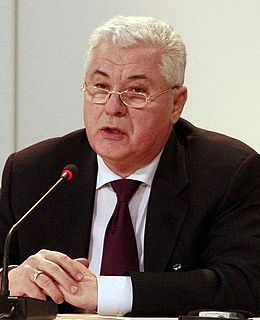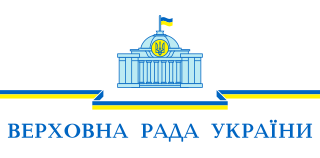
Arnold RüütelOIH served as the last Chairman of the Presidium of the Supreme Soviet of the Estonian SSR from April 8, 1983, to March 29, 1990, Chairman of the Supreme Soviet of the Estonian SSR from March 29, 1990, to October 6, 1992, and was the third President of Estonia from October 8, 2001, to October 9, 2006. He was the second President since Estonia regained independence in 1991. Rüütel also served as one of fifteen Deputy Chairmen of the Supreme Soviet of the USSR.

Vladimir Antonovich Ivashko, was a Soviet Ukrainian politician, briefly acting as General Secretary of the Communist Party of the Soviet Union (CPSU) during the period from 24 August 1991 to 29 August 1991. On 24 August Mikhail Gorbachev resigned, and on 29 August the CPSU was suspended by the Supreme Soviet. Before becoming General Secretary he had been voted Gorbachev's Deputy General Secretary within the Party on 12 July 1990, a newly created position as a result of the 28th Congress of the Communist Party

The Latvian Soviet Socialist Republic, also known as Soviet Latvia or Latvia, was a republic of the Soviet Union.

Vladimir Voronin is a Moldovan politician. He was the third President of Moldova from 2001 until 2009 and has been the First Secretary of the Party of Communists of the Republic of Moldova (PCRM) since 1994. He was Europe's first democratically elected Communist Party head of state after the dissolution of the Eastern Bloc.

The Verkhovna Rada of Ukraine, often simply Verkhovna Rada or just Rada, is the unicameral parliament of Ukraine. The Verkhovna Rada is composed of 450 deputies, who are presided over by a chairman (speaker). The Verkhovna Rada meets in the Verkhovna Rada building in Ukraine's capital Kiev.

The National Assembly, also transliterated as Milli Majlis, is the legislative branch of government in Azerbaijan. The unicameral National Assembly has 125 deputies: previously 100 members were elected for five-year terms in single-seat constituencies and 25 were members elected by proportional representation; as of the latest election, however, all 125 deputies are returned from single-member constituencies. Milli Majlis was the first secular republican parliament in the Muslim world.

The Act of the Re-Establishment of the State of Lithuania or Act of March 11 was an independence declaration by the Lithuanian Soviet Socialist Republic adopted on March 11, 1990, signed by all members of the Supreme Council of the Republic of Lithuania led by Sąjūdis. The act emphasized restoration and legal continuity of the interwar-period Lithuania, which was occupied by the USSR and lost independence in June 1940. It was the first time that an occupied state declared independence from the dissolving Soviet Union.
The Congress of Estonia was an innovative grassroots parliament established in Estonia as a part of the process of regaining of independence from the Soviet Union. It also challenged the power and authority of the pre-existing quasi-parliament in the country, called the Supreme Soviet of the Estonian SSR, which had been imposed on Estonia after Moscow's illegal annexation in 1940. The Congress of Estonia declared that it represented the highest authority on questions of Estonian statehood and citizenship, deriving this authority from the consent and initiative of the citizens of Estonia. The aim of the Congress was to restore Estonian independence based on the principle of legal continuity, with the pre-1940 republic of Estonia, which had been established in 1918, as the foundation.

The Supreme Soviet of the Lithuanian SSR was the supreme soviet of the Lithuanian SSR, one of the republics comprising the Soviet Union. The Supreme Soviet was established in August 1940 when the People's Seimas declared itself the provisional Supreme Soviet. According to the constitution it was very similar to modern democratic parliaments: it was elected every four years and had the power to create, amend and ratify the constitution, laws, and treaties and appoint officials in the Council of Ministers. However, in reality the elections were staged, the Soviet had very little actual power and carried out orders given by the Communist Party of Lithuania (CPL). The situation changed in 1988, when the Lithuanians began seeking independence from the Soviet Union. The political power shifted from CPL to the Soviet, which adopted a number of important constitutional amendments and laws, paving the way for the independence. The first free elections were held in February 1990 and were won by pro-independence Sąjūdis. During its first session the Supreme Soviet adopted the Act of the Re-Establishment of the State of Lithuania and renamed itself the Supreme Council of the Republic of Lithuania.
The first relatively free election to the Supreme Soviet (Rada) held in the Ukrainian Soviet Socialist Republic took place in several stages, from March 4 to March 18, 1990. The elections were held to elect deputies to the republic's parliament, the Verkhovna Rada. Simultaneously, elections of local provincial ("oblast'") councils also took place in their respective administrative divisions.

Parliamentary elections were held in the Georgian SSR on 28 October 1990, with a second round on 11 November. They were the first free parliamentary election in since 1919, and saw Round Table-Free Georgia emerge as the largest party in Parliament, with 155 of the 250 seats. Voter turnout was 69.9%.
The Lithuanian legislative elections for 141 seats in the Supreme Soviet of the Lithuanian SSR were held in the Lithuanian SSR on 24 February with run-off elections on 4, 7, 8 and 10 March 1990. In six constituencies voter turnout was below required minimum, therefore a third round was held on April 7 and 21. For the first time since the election to the People's Seimas in 1940, non-communist candidates were allowed to run. It was the first and the only free multi-party elections in Soviet Lithuania. Pro-independence Sąjūdis movement refused to become a political party and endorsed candidates of various other political parties based on their personal merits. These endorsements often meant more than official party affiliations, and Sąjūdis-backed candidates won 91 out of 135 seats. During its third session on 11 March 1990, the Supreme Soviet of the Lithuanian SSR adopted the Act of the Re-Establishment of the State of Lithuania thus declaring Lithuania's independence from the Soviet Union.
Elections to the Supreme Soviet were held in the Estonian SSR on 18 March 1990, the first free parliamentary election in Estonia since 1932. A total of 105 deputies were elected, of which four were from military districts. Altogether 392 candidates ran for seats in the Soviet. The opposition pro-independence Popular Front won the plurality of the seats. The anti-independence "Joint Council of Work Collectives", representing mostly the Russian-speaking minority in Estonia, as well as the reformed communists, who favored independence but close relations with the USSR and were supported by Indrek Toome, who was running under the Free Estonia banner, both gained around 25 seats. During its first session, the new Supreme Soviet elected the former Communist Party member Arnold Rüütel as its chairman, allowing him to stay as the nominal leader of Estonia.
The Supreme Soviet was the common name for the legislative bodies (parliaments) of the Soviet socialist republics (SSR) in the Union of Soviet Socialist Republics (USSR). These soviets were modeled after the Supreme Soviet of the USSR, established in 1938, and were nearly identical. Soviet-approved delegates to the Supreme Soviets were periodically elected in unopposed elections. The first free or semi-free elections took place during perestroika in late 1980s. The soviets until then were largely rubber-stamp institutions, approving decisions handed to them by the Communist Party of the USSR or of each SSR. The soviets met infrequently and elected the Presidium of the Supreme Soviet, a permanent body, to act on their behalf while the soviet was not in session. Under the 1936 and 1977 Soviet Constitutions the Presidium of the Supreme Soviet served as the collective head of state of the USSR. The Supreme Soviets also elected the Council of Ministers, an executive body. After the dissolution of the USSR in late December 1991, most of these soviets became the legislatures of independent countries.
The term People's Parliaments or People's Assemblies was used in 1940 for puppet legislatures put together after show elections in Estonia, Latvia, and Lithuania to legitimize the occupation by the Soviet Union. In all three countries, the elections to the parliaments followed the same scenario, dictated by functionaries in Moscow and borrowed from incorporation of Belarusian and Ukrainian lands in the aftermath of the invasion of Poland in 1939.

An election for a Supreme Soviet took place in Moldavia in 1940. The poll was an effort to legitimize the Soviet occupation of Bessarabia and Northern Bukovina which had taken place immediately prior. Since 1918 these regions had been part of Romania. All deputies returned were members of the Communist Party of Moldavia, a branch of the Communist Party of the Soviet Union. The Supreme Soviet subsequently adopted the 1941 Constitution of the Moldavian Soviet Socialist Republic, under which the MSSR was a constituent of the Soviet Union. Soviet control was interrupted by the Axis occupation from 1941 to 1944.
Parliamentary elections were held in Estonia on 14 and 15 July 1940 alongside simultaneous elections in Latvia and Lithuania. The elections followed the Soviet occupation of the three countries, and were rigged. The Estonian Working People's Union, a Communist front group, was the only party allowed to run, and won all 80 seats with 92.8% of the vote. The newly elected People's Parliament declared the Estonian SSR on 21 July and requested admission to the Soviet Union the following day. The request was approved by the Soviet government on 6 August.

The dissolution of the Soviet Union occurred on 26 December 1991, officially granting self-governing independence to the Republics of the Union of Soviet Socialist Republics (USSR). It was a result of the declaration number 142-Н of the Supreme Soviet of the Soviet Union. The declaration acknowledged the independence of the former Soviet republics and created the Commonwealth of Independent States (CIS), although five of the signatories ratified it much later or did not do so at all. On the previous day, 25 December, Soviet President Mikhail Gorbachev, the eighth and final leader of the USSR, resigned, declared his office extinct and handed over its powers—including control of the Soviet nuclear missile launching codes—to Russian President Boris Yeltsin. That evening at 7:32 p.m., the Soviet flag was lowered from the Kremlin for the last time and replaced with the pre-revolutionary Russian flag.















